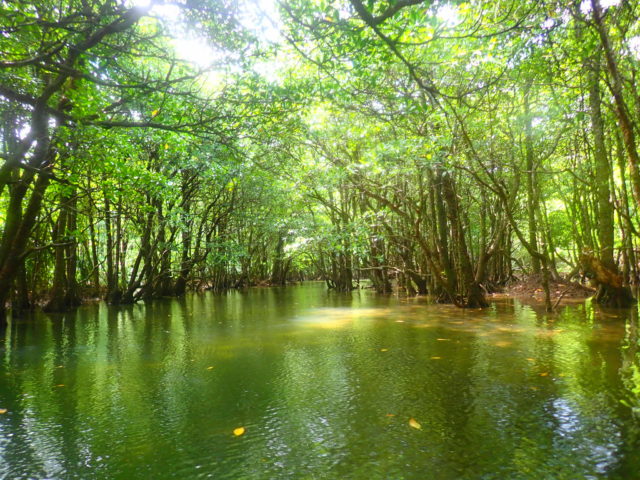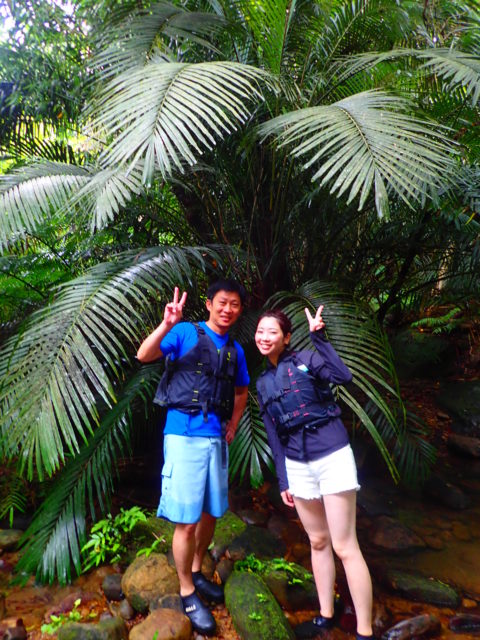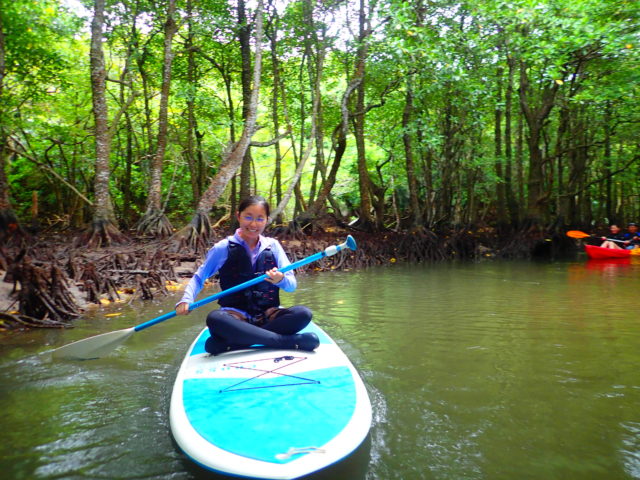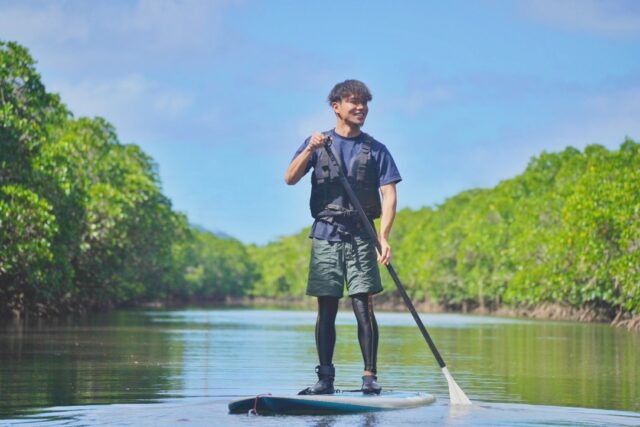Local Column
COLUMN

Basic Information on Iriomote Island
目次
About the Yaeyama Islands including Iriomote Island
When Okinawa Prefecture is mentioned, most people probably think of the main island of Okinawa, where Naha City is located.
However, Okinawa Prefecture is made up of numerous islands, and there are several islands that are as attractive as the main island of Okinawa as tourist destinations.
Among these, the Yaeyama Islands are particularly popular, consisting of islands such as Ishigaki Island, which is popular as a resort destination, and Iriomote Island, with its magnificent natural environment.
The Yaeyama Islands, consisting of 32 islands of various sizes, include Ishigaki, Taketomi, Kohama, Kuroshima, Aragusuku, Iriomote, Hatoma, Yubu, Hateruma, Yonaguni and 10 inhabited islands.
The distance from Ishigaki Island at the eastern end to Yonaguni Island at the western end is about 120 km, which may give you an idea of how vast the waters of the Yaeyama Islands are.

This time, we would like to look at various information about Iriomote Island, one of the core islands of the Yaeyama Archipelago, which is full of nature.
Geography of Iriomote Island
Let's start with the characteristics of geography.
Iriomote Island has a very large area for an island, the second largest in the prefecture after Okinawa Island.
It is located on the west side of Ishigaki Island, more than 400 km from the mainland, and much closer to Taiwan than to the main island of Okinawa.
Because of this location, Iriomote Island is very warm throughout the year.
Unlike the mainland, the climate is subtropical, with temperatures often exceeding 20°C (68°F) even in winter.
It is worth mentioning that the temperature already reaches early summer in the spring, and the sea opens already as early as March.
The rainy season comes early, about a month earlier than on the mainland, and the rainy season ends in early June.
Because of its subtropical climate, it is hot and humid, and the heat that covers the entire island during the rainy season is extremely sweltering.
The way of rainfall is also different from that of the mainland, and the rain in Iriomotejima is of a squall-like nature, falling hard for a short time and stopping soon after.
The land is basically hot and humid, and rainfall is quite high.
Another geographical feature is that it is a land of strong winds.
This is because Iriomote Island is a remote island, surrounded by the sea on all sides.
In particular, there are no shadows on the north side of the island to block the wind, and especially in winter, strong northerly winds blow due to the influence of air masses.
It should be noted that even in winter, the temperature itself is often mild, but this wind can cause the temperature to be lower than the numbers indicate.
Now, such a subtropical climate environment produces a large jungle, which is the island's greatest character and attraction.
It is said that more than 90% of the vast area of Iriomote Island is occupied by this jungle.
Because of the large number of rare plants and animals that inhabit this jungle, there has been little cultivation or development outside of the ocean-facing periphery.
Many islands in Okinawa Prefecture were created by rising coral reefs, and these islands have flat terrain with no mountains, but Iriomote Island has mountains, rivers, and even waterfalls.
Another special feature is that it is the only one of the archipelago that has hot springs, due in part to the volcanic veins running through it.
The population of Iriomote Island is a little over 2,400 as of 2020.
A road runs eastward around the perimeter of the island from northwest to south, but there is no road leading to the southwest.
Nature of Iriomote Island

As mentioned above, the great jungle of Iriomote Island is home to a wide variety of creatures.
As for the biota, it is known as a very valuable place academically, with many national monuments such as the Iriomote wildcat, crested serpent eagle, and semalpine box turtle.
In addition, the area is home to a wide variety of other creatures such as coconut crabs, Jonaguni horses, Yaeyama flying foxes, and giant sesame corals, and plays an important role as a tourist resource.
In addition to animals, the jungle is also home to rare plants.
One famous example is the mangroves that thrive near the mouth of the river.
Although mangroves can be seen on other islands in Okinawa Prefecture, Iriomote Island is very suitable for growing mangroves because of its abundant rainfall and water as well as its large river.
In particular, the mangroves in the Nakama River basin account for about a quarter of the total mangrove area in Japan, and it is said that 801 TP3T of the mangroves in Japan are located on Iriomote Island.
The island is also filled with other rare plants too numerous to enumerate, such as the saxifrage tree with roots shaped like boards, Japan's largest bean modama (the motif of Jack and the Beanstalk), and the famous banyan tree.
Culture of Iriomote Island

A unique culture has taken root on Iriomote Island, with its own unique festivals.
One of the most interesting is the Harvest Festival held in the Komi district of the island.
The belief that masked deities visit the island during the festival season to bring benefits is deeply rooted in Iriomote Island. During the harvest festival, residents wear masks and dress up as the deities Akamata, Kuromata, and Shiromata.
These three gods (Akamata, Kuromata, and Shiromata) appear on the second day of the Harvest Festival.
Three gods, each wearing a red, black, and white mask and covered with grass, descend from the mountain.
They beat gongs and drums and sing a song called "Yunta" to pray for a good harvest.
This festival is sacred, treated locally as a secret festival, and photography, recording, and sketching are prohibited.
It is a complex festival, so I won't go into the details, but it is one of the most striking features of Iriomote Island's culture.
The food culture is also unique, with foods such as kamai, sawfish, and island octopus.
Kamai is the dialect name for the Ryukyu wild boar, a native species of boar that is pure and unadulterated with pigs.
Since they are vermin that destroy crops, they are actively exterminated on Iriomote Island, and the culture of eating kamai has taken root to the extent that it is said that "the only place to throw away is the tail.
As the saying goes, not only the meat, but also the bones, liver, heart, and even the blood are all edible.
Fresh wild boar can be eaten raw as sashimi, without the distinctive smell of wild boar, if the blood is drained properly.
Note, however, that the local health department urges against eating raw from the standpoint of food poisoning.
Sawtooth turban shells are a very rare crab species and are taken in the rivers near the mangrove forests in Iriomote Island because they prefer to live in brackish water.
A large crab, sometimes over 20 cm in length, with firm and satisfying meat.
It tastes so good that it is treated as a luxury food, and is often eaten locally boiled, steamed, or in soup dishes where it can be used to make dashi (Japanese soup stock).
The island octopus is a type of octopus that is often caught when the water temperature is cooler.
Hidden among corals and rocks, it is eaten raw as sashimi and carpaccio, or as tempura, simmered dishes, etc.
These are just a few of the typical examples, but there is a wide variety of other food culture unique to the islands.
You can see that the highly diverse environment of Iriomote Island has given birth to a variety of food cultures.
Industries of Iriomote Island
Iriomote Island, like the rest of Okinawa Prefecture, has a particularly active primary industry based on its rich natural environment and a tertiary industry, tourism.
The beautiful nature of Iriomote Island has even been rated by the Michelin Green Guide.
In addition, Iriomote Island has been recommended by the Japanese government to UNESCO as part of the World Natural Heritage candidate sites, and is unique in that all of its nature, including jungle, ocean, rivers, and waterfalls, is used as a tourism resource.
Many local tours are available for water activities such as snorkeling, diving, SUP, and canoeing at the water's edge, as well as trekking and canyoning in the jungle.
Meat, fish, and vegetables from the island's natural environment are of the highest quality, and the subtropical climate supports local industries such as sugarcane cultivation, rice and fruit tree cultivation, Ishigaki cattle breeding, and fishery.
Sugarcane and tropical fruits like pineapple grown on the island are also used in processed foods, and are popular products that are sold in response to the demand for souvenirs.
In general, it can be said that the industry of Iriomote Island is built in symbiosis with its nature.
Best season in Iriomote Island

Iriomote Island is an environment rich in nature, so you can enjoy Iriomote Island in any season, but when is the most suitable season for sightseeing?
It is difficult to pick out one, because there are various points of view, but if you dare to narrow it down, the best time to visit Iriomote Island may be around the end of the hot and humid rainy season.
Generally, July and August are said to be the best season and attract more tourists, but since June is still out of season, travel expenses such as transportation and lodging can be kept low.
From a cosmetic standpoint, June is a relatively good time to visit.
Also, as introduced in the geography section, the rainy season in Iriomote Island starts in May and ends in early June.
Therefore, from mid-June onward, the rainy season will be over and the blue sky and temperatures will be summery, and you will be able to enjoy everything from swimming to waterfront activities with a refreshing feeling.
Many tourists from all over Japan visit Iriomote Island in July and August, as the weather never breaks and the clear skies continue.

The summer vacation period for students is also a time of year when the island is crowded with people, and while the climate is ideal for a tropical getaway, the fact that the island can be overcrowded with tourists can be a disadvantage.
You have come to Iriomote Island for the purpose of tasting the great nature of Iriomote Island, but if the tourist spots are crowded with people like bathing beaches, you may often feel inconvenienced on your trip.
From this perspective, June is the best month overall to enjoy the summer of Iriomote Island in a stress-free environment without too many tourists.
A word of caution, however: if you visit in early June, even in June, you will be in the middle of the rainy season.
We would like to visit the area after the rainy season has ended, and not prematurely.
in the end
We have introduced various basic information about Iriomote Island.
If you are heading all the way to Iriomote Island for a trip, in-depth advance research is essential.
By pressing the best season of Iriomote Island, you will be able to enjoy your trip efficiently while consulting with your financial situation.
Also, if you know about industries and cultures such as livestock and fisheries, you are guaranteed to enjoy a more in-depth trip to Iriomote Island.
We hope you will enjoy a fulfilling trip with our prior knowledge!

